
Dedicated supermarket milk pools have offered embattled dairy farmers rare respite during the current milk crisis. But their future is increasingly in doubt - they are expensive to run, and some farmers claim they exacerbate inequalities in UK dairy farming.
So are pools still delivering for retailers, farmers and consumers? What does the future hold for them?
The timeline of the battle of the bottle
3 March 2014: Tesco cuts price of four pints to £1
5 March 2014: Sainsbury’s and Co-op follow Tesco
6 March 2014: Waitrose and Nisa respond
7 March 2014: Morrisons slashes price to 24p a pint
21 March 2014: Aldi slashes price to 95p for four pints
15 August 2014: Waitrose slashes price to £1 for four pints
13 October 2014: Iceland drops price of four pints to 89p
5 January 2015: Asda slashes price of four pints of milk to 89p
25 June 2015: Sainsbury’s drops price of two pints from 89p to 75p and a pint from 49p to 45p
4 July 2015: Tesco responds to Sainsbury’s on pint prices
7 July 2015: Asda follows JS in cutting one and two-pinters
13 July 2015: Morrisons cuts price of two-pinters to 74p
24 July 2015: Aldi cuts price to 74p
The past year has been tough for dairy. Ever since the most recent milk price war began last March, four and six-pinters have been used as heavy artillery to lure in shoppers, with two- and one-pinters being dragged into the melee in June, when Sainsbury’s dropped the price of two pints from 89p to 75p and the price of a pint from 49p to 45p. Others soon followed.
As a result, some £97.7m has been wiped off the value of the category over the past 12 months, a drop of 3% [Kantar Worldpanel 52 w/e 24 May]. However, volumes have risen 3.5% to 5.49 billion litres - an important achievement at a time when the market is suffering from a surplus of milk.
Still, dairy farmer protests have put supermarket milk buying practices in the spotlight. This is where dedicated retail pools should prove a useful PR weapon. Farmers who sell their milk into such pools receive a premium, typically based on the cost of production as well as other factors, allowing retailers to reassure customers that farmers aren’t being squeezed even if retail prices are low.
But it’s a costly set-up. Those retailers with dedicated pools (such as Tesco, Sainsbury’s, The Co-operative Group, Waitrose and Marks & Spencer) currently pay their farmers about 30ppl compared with around 23ppl that “non-aligned” farmers, whose milk ends up at Asda, Morrisons, Lidl and Aldi, receive. On top of that, there’s the cost of segregating - keeping the milk separate in factories as well as having “dedicated” milk tankers criss-crossing “non dedicated” ones around the countryside. Industry experts believe this haulage and separation inefficiency adds up to another 1ppl.
A best-estimate calculation based on own-label fresh milk volumes and farmgate prices since 2010 suggests retailers with dedicated pools have paid a whopping £500m ‘extra’ for their milk over the past five years. This year, the bill could hit as much as £200m in extra milk costs, as the difference between aligned and non-aligned farmer prices has widened to nearly 8.5p.
At the same time, Kantar data suggests aligned retailers aren’t faring better in terms of milk sales than those simply paying market rates. Over the past five years, retailers with aligned pools have collectively increased their milk volume sales by 10.6%, while non-aligned retailers have seen a jump of 19%, with much of that down to the explosive growth of the discounters [see right].
With margins under pressure, it’s little wonder retailers are starting to ask tough questions of their milk pools.
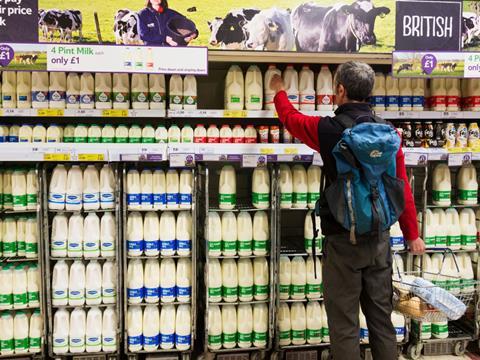
Tesco review
In July, Tesco announced it was launching a comprehensive review of its Tesco Sustainable Dairy Group (TSDG). By its own admission, Tesco has invested about £200m in TSDG since its launch in 2007; this year alone, and based on TSDG milk volumes of an estimated one billion litres a year, it may easily end up paying £75m more for its milk than if it had paid market rates.
“That Tesco is reappraising its milk procurement cannot be considered surprising given the financial constraints,” says Clive Black, head of research at Shore Capital. “A better balance is necessary where more flexibility is injected into the trading arrangements as opposed to just milk production costs.”
Perhaps counter-intuitively, farmers aren’t necessarily fans of dedicated pools either. While NFU dairy board chairman Rob Harrison praises retailers with pools for having a “transparent system that decouples what they pay their farmers from the retail price”, others worry they are inefficient and divisive.
Just 15% of the UK’s milk goes into retailer pools, meaning no matter how laudable or forward-thinking individual pools may be, the vast majority of British dairy farmers don’t benefit from them and are, in fact, being significantly affected by them. For example, farmers on poor milk prices in the non-aligned pools are having to sell cows, which are being bought by those in aligned pools who are then producing even more milk that continues to supress the price of the non-aligned. It’s a vicious cycle.
“That Tesco is reappraising its milk procurement cannot be considered surprising given the financial constraints”
So with this in mind, how might the retailer pool model evolve? Although no details are known of the Tesco TSDG review, it is expected it will look closely at its cost of production model, and take steps to reduce it in order to cut the astronomical cost of the scheme.
Improved consumer communication is also likely to play a big role. Dedicated milk pools were set up primarily to ensure security of supply, but retailers clearly also hoped they might get some credit from consumers for ‘doing the right thing’ by farmers. However, in a recent Harris survey for The Grocer, when consumers were asked which retailer they thought paid the best price to farmers Tesco and Sainsbury’s didn’t fare at all well. In fact, none of the multiples did - it was the c-stores and independents that came out top.
No matter what the outcome of the TSDG review, experts suggest all retailers need to start asking tough questions about the impact of their milk price war tactics. “We do feel more investigation is needed into the real effect on supermarket sales of the price cuts in milk - have the stores really benefited from this process?” says Alex Bandini, strategic insight director for Kantar.
Tesco’s next move in particular could be a game changer for the milk price war, suggests commentator Ian Potter. “The sheer cost of the TSDG means every time a rival cuts their milk price they know Tesco is going to haemorrhage huge amounts of money. It sells the most milk, it pays a very high price for its milk, and it has the most to lose. Cutting the milk price weakens Tesco, and that’s exactly what its rivals want.”

If Tesco manages to reduce its exposure following the TSDG review, its rivals could well be more disposed towards halting the race to the bottom on milk.
In the meantime, many believe creating added-value milks is still the best way to persuade shoppers to pay more. Already a number of new brands and ideas are coming to the fore such as Omega 3 milk, nutrient-enriched Nemi milk, free-range dairy milk and Arla’s Big Milk brand.
“Retailers are desperate to find ways to inject value into the category to replace the lost margins,” says Ash Amirahmadi, vice president, milk and member services for Arla Foods. “They want our help, and they want brands, which is why we invest in Cravendale and launched Big Milk.”
“Retailers are desperate to find ways to inject value into the category to replace the lost margins”
Not that this is easy in the current climate. Kantar data shows volume and value sales for filtered milk are down 4.6% and 7.4% year on year. Still, Bandini is upbeat about added-value milks. “Price cuts have focused on standard fresh milk, and shoppers initially switched away from filtered and organic milk as the price gap widened,” he says. “However, dairy alternatives and lactose-free milks are thriving, and filtered milk sales have also returned to growth in the last few months, suggesting shoppers will pay more for certain benefits.”
The reality is, though, sales of specialised milks will be always be low compared with the mainline blue, green or red top versions of the white stuff. That’s the key battleground. With farmers barricading distribution centres once more in a bid for more money - and retailers conceding - there are few signs of this war ending soon.
This article is part of our Dairymen feature.
How retailers measure up in milk supply arrangements
● Tesco: Tesco set up its TSDG group in 2007, and since then has paid 600 or so producers a cost-of-production related price, determined independently by farm consultants Promar, of an average of 115% of the non-aligned liquid price, and reaching a maximum of 138% this year. In addition to the liquid milk producers there are another 30 or so supplying milk for Tesco mature cheese in the TSDG.
● Sainsbury’s: Sainsbury’s also has a dedicated pool, with 320 farmers in its Sustainable Dairy Development Group. Its farmers get paid an independently assessed cost of production model, via Kite Consulting, which builds in a profit margin as well as rewarding good animal welfare and environmental standards such as carbon efficiency.
● Asda: Asda was the first of the big retailers to have a dedicated Dairylink pool, setting it up in 2004, and paying a premium to its 300 or so farmers. It has sourced all its milk from Arla Foods since then, which, as a farmer-owned co-op, has a policy of paying all its 13,500 farms across Europe the same price. In late 2012, Asda decided a fairer policy was to share the premiums it paid for milk among all Arla farmers rather than a select few.
● The Co-operative: The Co-op has had a dedicated relationship with just over 200 dairy farmers, exclusively within Müller-Wiseman, since 2011. They are also paid a premium over the average. Within this group, there are 15 smaller producer groups across England, Scotland and Wales.
● Morrisons: Morrisons buys its milk from Dairy Crest and Arla (and in Scotland from Graham’s). It does not have a dedicated milk pool but says it is still close to farmers.
● Waitrose: Waitrose has one of the longest-running dedicated milk pools, originally setting it up in 2000. Since then it has consistently paid one of the highest prices in the marketplace, and one related to cost of production.
● Lidl: Lidl doesn’t have a dedicated pool but says it works “very closely with farm assurance schemes such as the Red Tractor, which ensures that farmers supplying us with liquid milk are treated fairly and supply a quality product.”
● Aldi: Aldi also has no dedicated pool. It insists “as part of our commitment to the UK dairy industry Aldi pays its processors above the farmgate price and sources all of our milk from Red Tractor assured farms”.



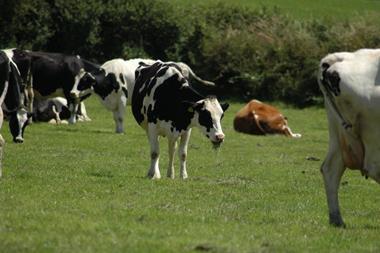
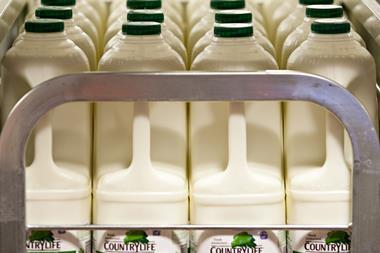






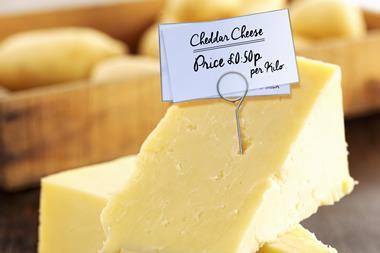


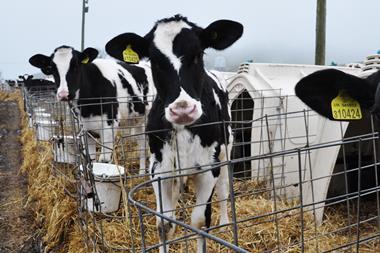
No comments yet